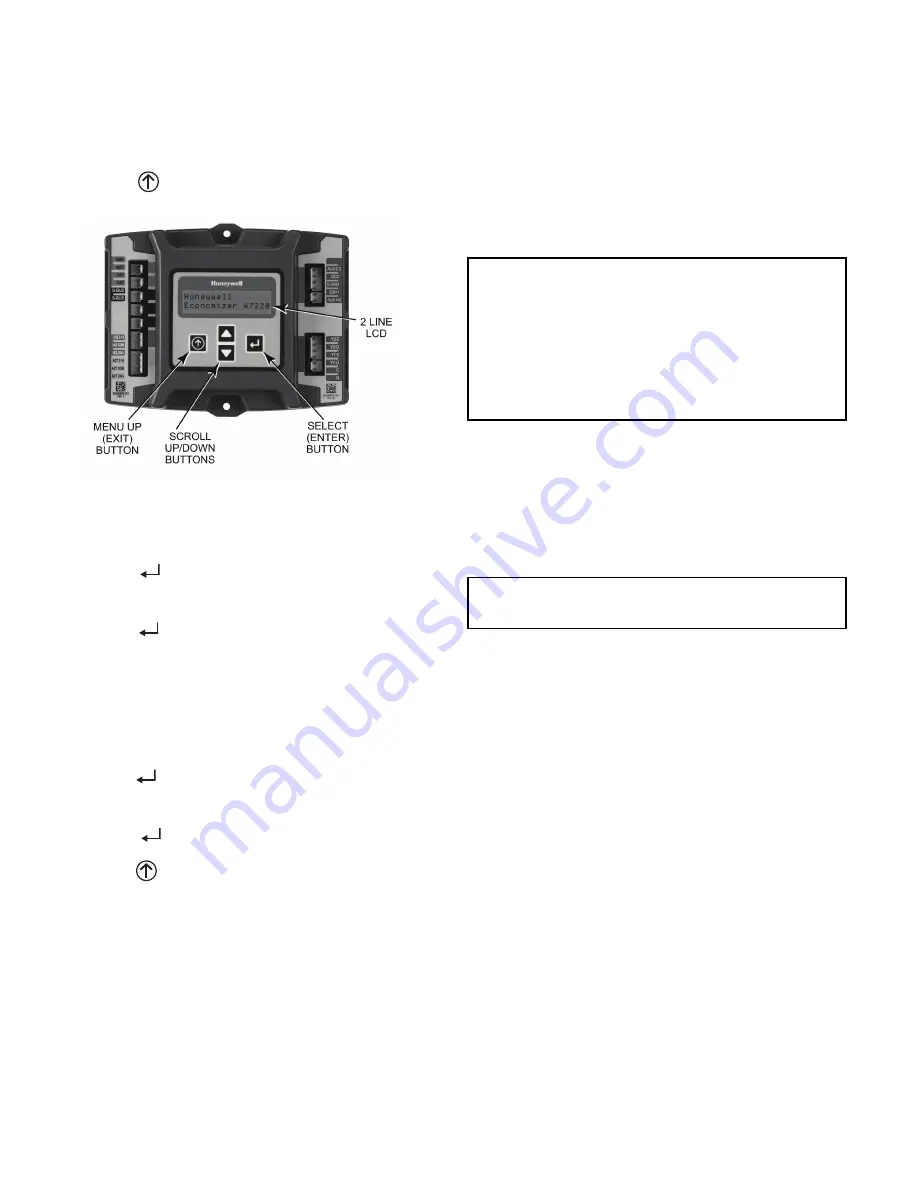
36
To use the keypad when working with menus:
• Press the
▲
(Up arrow) button to move to the previous
menu.
• Press the
▼
(Down arrow) button to move to the next
menu.
• Press the (Enter) button to display the first item in the cur-
rently displayed menu.
• Press the
(Menu Up/Exit) button to exit a menu’s item
and return to the list of menus.
Fig. 50 — W7220 Controller Menu Buttons
To use the keypad when working with Setpoints, System and Ad-
vanced Settings, Checkout tests and Alarms:
1. Navigate to the desired menu.
2. Press the
(Enter) button to display the first item in the
currently displayed menu.
3. Use the and buttons to scroll to the desired parameter.
4. Press the
(Enter) button to display the value of the cur-
rently displayed item.
5. Press the
▲
button to increase (change) the displayed param-
eter value.
6. Press the
▼
button to decrease (change) the displayed param-
eter value.
NOTE: When values are displayed, pressing and holding the or
button causes the display to automatically increment.
7. Press the
(Enter) button to accept the displayed value and
store it in nonvolatile RAM.
8. “CHANGE STORED” displays.
9. Press the
(Enter) button to return to the current menu
parameter.
10. Press the
(Menu Up/Exit) button to return to the previous
menu.
MENU STRUCTURE
Table 12 illustrates the complete hierarchy of menus and parame-
ters for the EconoMi$er
®
X system.
The Menus in display order are:
• STATUS
• SETPOINTS
• SYSTEM SETUP
• ADVANCED SETUP
• CHECKOUT
• ALARMS
NOTE: Some parameters in the menus use the letters MA or
MAT, indicating a mixed air temperature sensor location before
the cooling coil. This unit application has the control sensor locat-
ed after the cooling coil, in the fan section, where it is designated
as (Cooling) Supply Air Temperature or SAT sensor.
SETUP AND CONFIGURATION
Before being placed into service, the W7220 Economizer module
must be setup and configured for the installed system.
The setup process uses a hierarchical menu structure that is easy to
use. You press the and arrow buttons to move forward and back-
ward through the menus and press the button to select and confirm
setup item changes.
TIME-OUT AND SCREENSAVER
When no buttons have been pressed for 10 minutes, the LCD dis-
plays a screen saver, which cycles through the Status items. Each
Status items displays in turn and cycles to the next item after
5 seconds.
IMPORTANT: Table 12 illustrates the complete hierarchy.
Your menu parameters may be different depending on
your configuration.
For example, if you do not have a DCV (CO
2
) sensor, then
none of the DCV parameters appear and only MIN POS will
display. If you have a CO
2
sensor, the DCV MIN and DCV
MAX will appear AND if you have 2 speed fan DCV MIN
(high and low speed) and DCV MAX (high and low speed
will appear).
IMPORTANT: During setup, the economizer module is
live at all times.
Содержание 48TC D/E17 Series
Страница 5: ...5 Fig 2 48TC 17 20 Vertical Airflow...
Страница 6: ...6 Fig 3 48TC 17 20 Back View and Condensate Drain Location...
Страница 7: ...7 Fig 4 48TC 17 20 Corner Weights and Clearances...
Страница 8: ...8 Fig 5 48TC 17 20 Bottom View...
Страница 9: ...9 Fig 6 48TC 24 28 Vertical Airflow...
Страница 10: ...10 Fig 7 48TC 24 28 Back View and Condensate Drain Location...
Страница 11: ...11 Fig 8 48TC 24 28 Corner Weights and Clearances...
Страница 12: ...12 Fig 9 48TC 24 28 Bottom View...
Страница 13: ...13 Fig 10 48TC 30 Vertical Airflow...
Страница 14: ...14 Fig 11 48TC 30 Back View and Condensate Drain Location...
Страница 15: ...15 Fig 12 48TC 30 Corner Weights and Clearances...
Страница 16: ...16 Fig 13 48TC 30 Bottom View...
Страница 19: ...19 Fig 16 Roof Curb Details 17 and 20 Size Units...
Страница 20: ...20 Fig 17 Roof Curb Details 24 and 28 Size Units...
Страница 21: ...21 Fig 18 Roof Curb Details 30 Size Units...
Страница 47: ...47 Fig 52 PremierLink Wiring Diagram...
Страница 48: ...48 Fig 53 PremierLink Wiring Diagram with Humidi MiZer System...
Страница 49: ...49 Fig 54 Typical RTU Open System Control Wiring Diagram...
Страница 50: ...50 Fig 55 Typical RTU Open System Control Wiring Diagram with Humidi MiZer System...
Страница 51: ...51 Fig 56 48TC 17 30 Control Wiring Diagram...
Страница 52: ...52 Fig 57 48TC 17 30 Power Wiring Diagram 208 230 3 60...
Страница 53: ...53 Fig 58 48TC 17 30 Power Wiring Diagram 460 3 60...
Страница 54: ...54 Fig 59 48TC 17 30 Power Wiring Diagram 575 3 60...
Страница 55: ...55 Fig 60 48TC 17 30 Control Wiring Diagram with Humidi MiZer System...
Страница 56: ...56 Fig 61 48TC 17 30 Power Wiring Diagram with Humidi MiZer System 208 230 3 60...
Страница 57: ...57 Fig 62 48TC 17 30 Power Wiring Diagram with Humidi MiZer System 460 3 60...
Страница 58: ...58 Fig 63 48TC 17 30 Power Wiring Diagram with Humidi MiZer System 575 3 60...






























